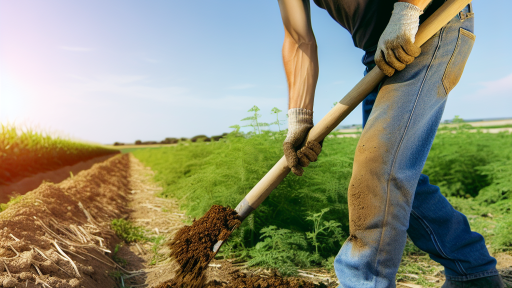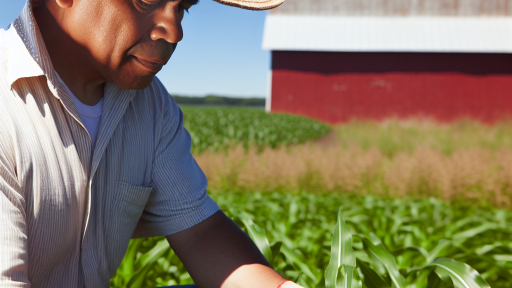Understanding the Importance of Harvest Timing for Quality and Yield
Maximizing Crop Potential
Harvest timing plays a crucial role in maximizing crop potential.
It directly influences both quality and yield of agricultural products.
When crops are harvested at the right moment, they reach peak flavor and nutrient content.
This ensures that consumers receive the best possible produce.
Consequently, farmers can enjoy higher market values and customer satisfaction.
Impact on Nutritional Value
Harvest timing significantly affects the nutritional value of crops.
Crops picked too early may lack essential nutrients.
On the other hand, those harvested too late can lose vital qualities.
Thus, farmers must monitor crop maturity closely.
Utilizing tools such as Brix meters can aid in determining optimal harvest points.
Influence on Storage and Shelf Life
Harvest timing also impacts storage capabilities and shelf life.
Crops that are picked at their prime will typically have longer shelf lives.
This occurs because they possess less moisture and higher sugar content.
Such factors help in reducing spoilage during storage and transit.
As a result, growers can minimize losses and enhance profitability.
Transform Your Agribusiness
Unlock your farm's potential with expert advice tailored to your needs. Get actionable steps that drive real results.
Get StartedEnvironmental Considerations
Furthermore, harvest timing can reflect environmental conditions.
Weather patterns can impact the ideal time for harvesting different crops.
For instance, an unexpected frost may necessitate an earlier harvest.
Farmers must remain adaptable and responsive to these changing conditions.
Therefore, monitoring the environment is essential for optimal outcomes.
Strategies for Effective Harvest Timing
Implementing effective harvest strategies is vital for success.
Regularly evaluating crop health and environmental conditions leads to better decisions.
Using technology, such as satellite imaging or drones, can aid in monitoring fields.
Additionally, farmers can establish a harvest schedule based on historical data.
This proactive approach helps in planning and resource allocation.
Factors Influencing Harvest Timing
Weather Conditions
Weather plays a crucial role in determining optimal harvest timing.
Temperature variations affect crop maturation significantly.
Furthermore, precipitation levels influence soil moisture and crop health.
Excessive rain can lead to disease, impacting yield quality.
Farmers should monitor weather forecasts regularly for better planning.
Crop Type
Different crops have unique harvesting requirements and timelines.
For instance, a corn crop typically matures in about 100 to 200 days.
In contrast, leafy greens may only require a few weeks to grow.
Thus, understanding specific crop varieties helps in planning effectively.
Moreover, each crop reacts differently to environmental conditions.
SoiL Conditions
SoiL health directly impacts crop growth and harvest quality.
Healthy soiL promotes stronger plant growth and resilience to diseases.
Furthermore, soiL moisture levels are vital for harvest timing decisions.
Farmers can assess soiL quality by conducting regular tests.
Showcase Your Farming Business
Publish your professional farming services profile on our blog for a one-time fee of $200 and reach a dedicated audience of farmers and agribusiness owners.
Publish Your ProfileAdditionally, appropriate soiL amendments can enhance yield outcomes.
Signs of Readiness: How to Identify the Optimal Harvest Window
Visual Indicators
Observe the color of your crops closely.
For many fruits and vegetables, a vibrant hue signals readiness.
In addition, monitor for any changes in skin texture.
Smooth skins may indicate crops are ripe and ready to harvest.
Note any signs of wrinkling or uneven surfaces.
These can suggest overripeness and potential spoilage.
Aroma and Taste
Smell is a powerful indicator of ripeness.
A strong, sweet aroma often means crops have reached their peak.
In addition, conducting taste tests can be enlightening.
Take a small sample of the crop to assess flavor.
Flavor should be rich and full when crops are ready.
Physical Checks
Perform a gentle squeeze test on fruits.
Fruits that yield slightly to pressure are typically ripe.
For grains, check the hardness of the kernel.
A firm kernel signifies that it is time to harvest.
In legumes, pods should be firm yet slightly pliable.
Weather Considerations
Consider the forecast leading up to harvest time.
Wet weather can adversely affect crop quality.
Plan for harvesting during dry conditions to enhance quality.
Additionally, avoid harvesting right before a significant rainfall.
Timing and Growth Cycles
Understand your specific crop’s growth cycle.
Each variety has its own optimal harvest window.
Track planting dates to forecast harvesting periods accurately.
Using growth charts can help you stay informed.
Moreover, consult agricultural extensions for local advice.
See Related Content: Maximizing Yield in Organic Crop Production
The Role of Testing: Moisture Levels and Sugar Content in Decision Making
Understanding Moisture Levels
Measuring moisture levels is crucial for harvest timing.
High moisture can lead to spoilage during storage.
Conversely, low moisture may result in reduced yield quality.
Farmers should regularly test moisture levels throughout the growing season.
Use reliable moisture meters to ensure accuracy.
Additionally, consider environmental factors affecting moisture.
Harvesting at optimal moisture levels maximizes quality.
The Importance of Sugar Content
Sugar content is essential for determining ripeness.
Higher sugar levels generally indicate better flavor.
Regularly testing for sugar can guide harvesting decisions.
Methods such as refractometers help measure sugar levels accurately.
Moreover, monitor sugar content for different crop varieties.
Different fruits and vegetables have unique sugar profiles.
Showcase Your Farming Business
Publish your professional farming services profile on our blog for a one-time fee of $200 and reach a dedicated audience of farmers and agribusiness owners.
Publish Your ProfileAim for optimal sugar levels specific to each type of produce.
Integrating Testing into Your Harvesting Strategy
Combine moisture and sugar testing for best results.
Schedule tests at key growth stages, such as pre-harvest.
Create a timeline that allows for adjustments based on test results.
Educate your team about the benefits of regular testing.
Ultimately, enhance yield and quality through informed decision-making.
See Related Content: Reducing Weeds Through Cover Cropping Strategies
Adjusting Harvest Techniques
Tools for Different Crops
Choosing the right tools significantly impacts harvest quality.
For fruits, hand-held picking tools enhance delicacy and minimize damage.
Vegetables often require knives or shears for precise cuts.
Mechanical harvesters work well for large scale operations.
Invest in tool maintenance to ensure optimal performance.
Harvesting Methods
Adjust methods based on crop type for maximum yield.
Consider the timing of your harvest carefully.
For example, early morning harvesting can retain freshness.
Similarly, avoiding rain helps maintain crop integrity.
Implement staggered harvesting for extended harvest windows.
Monitoring Crop Readiness
Regularly check for signs of ripeness as you approach harvest time.
Visual cues vary with each crop type, so learn the specifics.
Utilize taste tests when applicable to assess quality.
Document conditions to refine future harvest practices.
Weather conditions can also significantly affect readiness.
Delve into the Subject: How Cover Crops Boost Water Retention in Soil

Impact of Delayed Harvesting
Consequences on Yield
Delayed harvesting negatively affects overall crop yield.
This occurs as crops become overripe and more susceptible to pests.
Additionally, excess moisture can lead to fungal diseases.
Both factors ultimately reduce the quantity of harvestable crops.
Effects on Quality
Quality deteriorates when harvesting is delayed past the optimal time.
Fruits and vegetables may lose their flavor and nutritional value.
Moreover, overripe produce develops undesirable textures.
This decline influences marketability and consumer satisfaction.
Cultivation Considerations
Farmers must monitor crop maturity closely during the growing season.
Establishing a timely harvesting schedule helps preserve yield and quality.
Utilizing appropriate tools can streamline the harvesting process.
Regular assessments ensure crops are picked at peak readiness.
Uncover the Details: Smart Farming Solutions For Crop Monitoring Needs
Post-Harvest Handling: Best Practices to Preserve Quality After Harvest
Importance of Quick Handling
Quick handling after harvest maintains the optimal quality of crops.
This helps reduce spoilage and enhances flavor.
Additionally, prompt processing increases market value.
Temperature Control
Maintaining appropriate temperatures is vital for post-harvest quality.
Showcase Your Farming Business
Publish your professional farming services profile on our blog for a one-time fee of $200 and reach a dedicated audience of farmers and agribusiness owners.
Publish Your ProfileCool temperatures slow down the respiration rate of crops.
Introduce cooling systems such as refrigerated trucks to transport produce.
Moreover, ensure immediate cooling for sensitive crops like berries.
Moisture Management
Controlling moisture levels prevents decay and spoilage.
Store crops in well-ventilated areas to promote airflow.
Cover produce with breathable materials to reduce moisture accumulation.
Regularly inspect stored products for any signs of dampness.
Regular Quality Checks
Implement a routine for conducting quality checks after harvest.
This ensures early detection of any spoilage or damage.
Train staff to identify signs of deterioration.
Create a checklist for regular inspections of stored produce.
Packaging Best Practices
Use suitable packaging materials to protect fresh produce.
Choose biodegradable options to promote sustainability.
Ensure packaging allows for ventilation to reduce moisture build-up.
Label each package with harvest dates for tracking freshness.
Educating the Workforce
Training employees on effective post-harvest handling is essential.
Conduct workshops to emphasize the importance of quality preservation.
Share best practices for handling crops at every stage.
Encourage a culture of care and attentiveness among workers.
Case Studies: Successful Harvest Timing Strategies from Experienced Farmers
Timely Harvesting in Corn Production
Mark Harrison, a corn farmer in Illinois, shares his experience.
He emphasizes the importance of moisture content.
Harvesting at 20% moisture maximizes yield quality.
Additionally, he monitors kernel hardness closely.
This method has significantly improved his market price.
Adjusting to Weather Patterns for Wheat
Linda Kowalski, a wheat farmer in Nebraska, adapts her strategy.
She analyzes weather forecasts for optimal harvest timing.
Rain can damage wheat quality, so timing is crucial.
Consequently, she adjusts schedules for anticipated storms.
This practice has led to higher yields consistently.
Fruit Harvesting Based on Sugar Levels
Tom Patel, who runs an organic orchard in California, focuses on sugar levels.
He conducts regular taste tests to determine ripeness.
Harvesting fruit with higher sugar increases consumer satisfaction.
This approach has boosted his sales by engaging local markets.
Collaborative Farming for Enhanced Outcomes
Elena Garcia shares a cooperative farming model in Texas.
Several farmers share data on crop readiness.
This collaboration ensures they harvest at the right time.
As a result, they collectively improve yield quality.
Teamwork has strengthened community ties and market reach.
Utilizing Technology for Precision Harvesting
James Lee, a tech-savvy farmer in Michigan, utilizes drones.
He surveys fields to assess crop health and readiness.
Showcase Your Farming Business
Publish your professional farming services profile on our blog for a one-time fee of $200 and reach a dedicated audience of farmers and agribusiness owners.
Publish Your ProfileMapping out the best harvest areas enhances efficiency.
His investment in technology has reduced waste significantly.
Moreover, he saves time and resources on manual checks.




